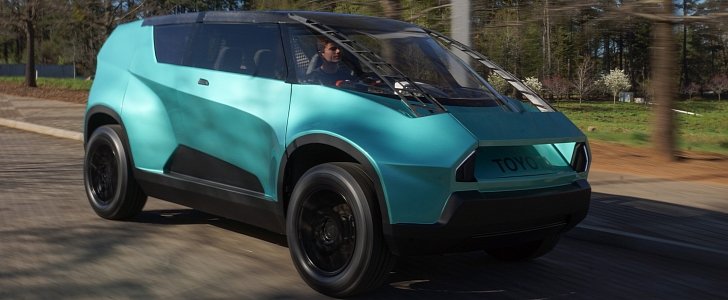Toyota has let a group of graduate students design, engineer, and hand-build a car intended for the next generation of customers.
In a two-year collaboration between Toyota Motor North America and Clemson University’s International Center for Automotive Research, the Toyota uBox concept was developed.
Toyota will exhibit the uBox today (April 12) at the Society of Automotive Engineers World Congress and Exposition at the Cobo Center in Detroit.
According to its creators, the typical customer of a Toyota uBox is “a young entrepreneur who requires a vehicle that can provide utility and recreation on the weekend, but that can also offer office space or other career-centric requirements during the week.” A brief translation of their description would be a vehicle for a young business person who needs a car to suit both work and personal needs.
The uBox comes with an all-electric powertrain, and that can also provide 110-volt AC for power tools or other devices which would suit the needs of the owner. Several sockets have been placed both inside and outside to cater to these requirements.
The interior of this concept is modular, and can be rearranged to suit various activities. Its secret is the flat floor, which includes sliding tracks for the removable seats and hides the batteries of the unspecified electric drivetrain.
Since the “Generation Z” buyers will have broad access to 3D printing technology, the air vents, dash bezels, and door trims can be personalized according to their preferences. The creators of this concept have imagined an online community where owners could share design ideas for these elements, which they could print and install without going to the dealer.
Toyota’s officials involved in the project were most impressed by the solution used to incorporate a curved glass roof. Students devised a set of composite carbon fiber rails, bonded with aluminum to the body, which support the curved glass roof.
The solution for the roof described above is an industry first, and such an achievement is impressive when it comes to a concept car, a category that usually includes most elements that carmakers cannot always introduce in production due to cost reasons.
Toyota will exhibit the uBox today (April 12) at the Society of Automotive Engineers World Congress and Exposition at the Cobo Center in Detroit.
According to its creators, the typical customer of a Toyota uBox is “a young entrepreneur who requires a vehicle that can provide utility and recreation on the weekend, but that can also offer office space or other career-centric requirements during the week.” A brief translation of their description would be a vehicle for a young business person who needs a car to suit both work and personal needs.
The uBox comes with an all-electric powertrain, and that can also provide 110-volt AC for power tools or other devices which would suit the needs of the owner. Several sockets have been placed both inside and outside to cater to these requirements.
The interior of this concept is modular, and can be rearranged to suit various activities. Its secret is the flat floor, which includes sliding tracks for the removable seats and hides the batteries of the unspecified electric drivetrain.
Since the “Generation Z” buyers will have broad access to 3D printing technology, the air vents, dash bezels, and door trims can be personalized according to their preferences. The creators of this concept have imagined an online community where owners could share design ideas for these elements, which they could print and install without going to the dealer.
Toyota’s officials involved in the project were most impressed by the solution used to incorporate a curved glass roof. Students devised a set of composite carbon fiber rails, bonded with aluminum to the body, which support the curved glass roof.
The solution for the roof described above is an industry first, and such an achievement is impressive when it comes to a concept car, a category that usually includes most elements that carmakers cannot always introduce in production due to cost reasons.









